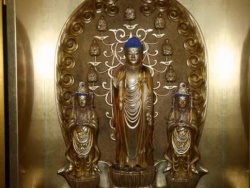Three truths
three truths
三諦 (Jpn san-tai )
Also, threefold truth, triple truth, or three perceptions of the truth. The truth of nonsubstantiality, the truth of temporary existence, and the truth of the Middle Way. The three integral aspects of the truth, or ultimate reality, formulated by T'ient'ai (538-597) in The Profound Meaning of the Lotus Sutra and Great Concentration and Insight. The truth of non substantiality means that phenomena have no existence of their own; their true nature is non-substantial, indefinable in terms of existence or nonexistence. The truth of temporary existence means that, although non-substantial, all things possess a temporary reality that is in constant flux. The truth of the Middle Way means that the true nature of phenomena is that they are neither non-substantial nor temporary, though they display attributes of both. The Middle Way is the essence of things that continues either in a manifest or a latent state. According to T'ient'ai's explanation, the Tripitaka teaching and the connecting teaching do not reveal the truth of the Middle Way and therefore lack the three truths. The specific teaching reveals the three truths but shows them as being separate from and independent of one another; that is, it does not teach that these three are inseparable aspects of all phenomena. This view is called the separation of the three truths. The perfect teaching views the three as an integral whole, each possessing all three within itself. This is called the unification of the three truths.
